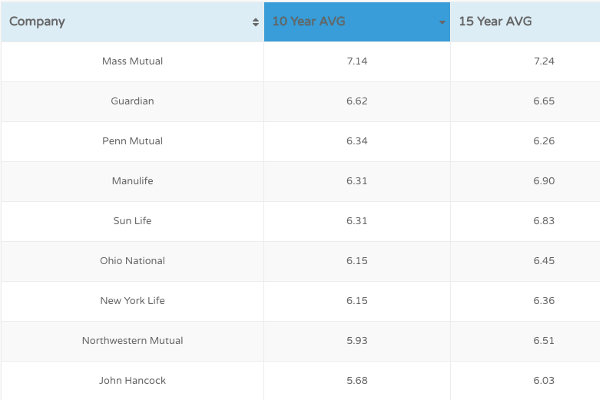As you age, your life insurance needs may change, and so too may the cost of your life insurance premiums. Term life insurance rates by age are typically determined by a variety of factors, including your age, health status, lifestyle habits, and coverage amount.
In this article, we will explore how age affects term life insurance rates and provide tips for choosing the right policy for you with the help of Top Whole Life, a reputable life insurance provider.
Term life insurance is typically more affordable than other types of life insurance, such as whole life insurance, because it provides coverage for a specific period of time and does not accumulate cash value.
For example, a 25-year-old non-smoker in good health may pay significantly less for a 20-year term life insurance policy than a 50-year-old non-smoker in good health. The 50-year-old is more likely to develop health issues or pass away during the term of the policy, which increases the insurance company's risk and therefore the cost of coverage.
According to data from Policygenius, the average cost of a 20-year term life insurance policy for a healthy 35-year-old is around $21 per month, while the same policy for a healthy 55-year-old can cost around $119 per month.
One factor that can affect the cost of life insurance premiums is the policyholder's age. As people age, their risk of health issues and mortality increases, and insurance companies account for this by charging higher premiums for older individuals. Here are some ways age can affect life insurance premiums:
Younger individuals tend to get better rates: Younger individuals, particularly those under the age of 35, often get the most affordable life insurance premiums since they are considered to be at a lower risk of health issues or death.
Rates increase with age: As individuals age, life insurance premiums tend to increase. This is because the likelihood of developing health issues and mortality risk both rise with age. Additionally, the term length for policies is usually shorter as you age, which means the policy has less time to accumulate value and the premiums are higher to compensate for that risk.
Age brackets affect premiums: Life insurance companies generally set premiums based on age brackets, with each bracket encompassing a certain range of ages. Premiums may be higher for the older end of the bracket than the younger end.
Age can affect policy options: Some policy types, such as term life insurance, may have age limits. If you are looking for a policy after a certain age, you may have to choose a different policy type, such as a whole life insurance policy.Medical history and lifestyle affect premiums: While age is a significant factor, other factors such as medical history and lifestyle choices can also play a role in determining life insurance premiums.
One of the best ways to lock in lower term life insurance rates is to purchase coverage while you are young and healthy. By doing so, you can take advantage of lower rates and potentially lock in coverage for a longer period of time.
Consider Your Coverage Needs
When choosing a term life insurance policy, it is important to consider your coverage needs. You should think about factors such as your income, debt, and the number of dependents you have, and choose a policy that provides enough coverage to meet your financial obligations and provide for your loved ones in the event of your death.
Choose a Shorter Term Length
If you are older and do not need as much coverage or have fewer financial obligations, you may want to consider choosing a shorter term length, such as a 10-year policy, to help keep your premiums lower.
Improve Your Health
Your health status is one of the most significant factors that determines the cost of your life insurance premiums. By improving your health through diet, exercise, and other healthy lifestyle habits, you may be able to qualify for better rates and save money on your life insurance premiums.
Age is a significant factor in determining life insurance premiums. As you age, your risk of health issues and mortality increases, which results in higher premiums. While younger individuals often get better rates, older individuals may have to pay higher premiums or consider different policy types. At Top Whole Life, we offer a variety of life insurance options tailored to your specific needs and budget, regardless of your age. Contact us today to learn more about how we can help you find the right policy for you.
In this article, we will explore how age affects term life insurance rates and provide tips for choosing the right policy for you with the help of Top Whole Life, a reputable life insurance provider.
Understanding Term Life Insurance
Term life insurance is a type of life insurance that provides coverage for a set period of time, typically ranging from 5 to 30 years. During this period, the policyholder pays regular premiums to the insurance company, and in the event of their death, their beneficiaries receive a lump sum payment, known as the death benefit.Term life insurance is typically more affordable than other types of life insurance, such as whole life insurance, because it provides coverage for a specific period of time and does not accumulate cash value.
How Age Affects Term Life Insurance Rates
Age is one of the most significant factors that affects term life insurance rates by age. As you age, your risk of death increases, which means that the insurance company will charge you more for coverage.For example, a 25-year-old non-smoker in good health may pay significantly less for a 20-year term life insurance policy than a 50-year-old non-smoker in good health. The 50-year-old is more likely to develop health issues or pass away during the term of the policy, which increases the insurance company's risk and therefore the cost of coverage.
According to data from Policygenius, the average cost of a 20-year term life insurance policy for a healthy 35-year-old is around $21 per month, while the same policy for a healthy 55-year-old can cost around $119 per month.
One factor that can affect the cost of life insurance premiums is the policyholder's age. As people age, their risk of health issues and mortality increases, and insurance companies account for this by charging higher premiums for older individuals. Here are some ways age can affect life insurance premiums:
Younger individuals tend to get better rates: Younger individuals, particularly those under the age of 35, often get the most affordable life insurance premiums since they are considered to be at a lower risk of health issues or death.
Rates increase with age: As individuals age, life insurance premiums tend to increase. This is because the likelihood of developing health issues and mortality risk both rise with age. Additionally, the term length for policies is usually shorter as you age, which means the policy has less time to accumulate value and the premiums are higher to compensate for that risk.
Age brackets affect premiums: Life insurance companies generally set premiums based on age brackets, with each bracket encompassing a certain range of ages. Premiums may be higher for the older end of the bracket than the younger end.
Age can affect policy options: Some policy types, such as term life insurance, may have age limits. If you are looking for a policy after a certain age, you may have to choose a different policy type, such as a whole life insurance policy.Medical history and lifestyle affect premiums: While age is a significant factor, other factors such as medical history and lifestyle choices can also play a role in determining life insurance premiums.
Secure your loved ones' future by getting the right life insurance coverage at the right price
Click below to get Quote NowGet Me A QuoteTips for Choosing the Right Policy Based on Age
Buy Coverage While You're YoungOne of the best ways to lock in lower term life insurance rates is to purchase coverage while you are young and healthy. By doing so, you can take advantage of lower rates and potentially lock in coverage for a longer period of time.
Consider Your Coverage Needs
When choosing a term life insurance policy, it is important to consider your coverage needs. You should think about factors such as your income, debt, and the number of dependents you have, and choose a policy that provides enough coverage to meet your financial obligations and provide for your loved ones in the event of your death.
Choose a Shorter Term Length
If you are older and do not need as much coverage or have fewer financial obligations, you may want to consider choosing a shorter term length, such as a 10-year policy, to help keep your premiums lower.
Improve Your Health
Your health status is one of the most significant factors that determines the cost of your life insurance premiums. By improving your health through diet, exercise, and other healthy lifestyle habits, you may be able to qualify for better rates and save money on your life insurance premiums.
Work with a Reputable Insurance Provider
Working with a reputable and experienced insurance provider such as Top Whole Life can help ensure that you receive competitive rates and comprehensive coverage. Top Whole Life has a team of experienced agents who can help you find the right policy for your needs and budget.Conclusion
Age is one of the most significant factors that affects term life insurance rates. As you age, the cost of coverage may increase, making it important to choose the right policy for your needs and budget.Age is a significant factor in determining life insurance premiums. As you age, your risk of health issues and mortality increases, which results in higher premiums. While younger individuals often get better rates, older individuals may have to pay higher premiums or consider different policy types. At Top Whole Life, we offer a variety of life insurance options tailored to your specific needs and budget, regardless of your age. Contact us today to learn more about how we can help you find the right policy for you.




